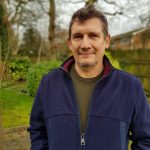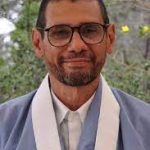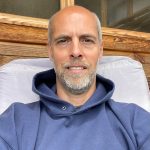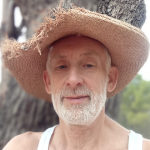
Achaladeva
Président
Je suis tombé amoureux de Guhyaloka lors de ma première visite en 1993 – le silence, la forêt, les vues magnifiques. Après avoir été ordonné ici en 1995 et avoir fait un certain nombre de retraites solitaires, j’ai rejoint la communauté en 2006, travaillant à l’entretien, à la gestion des terres et à certains projets de construction, y compris l’achat et le développement d’Uttaraloka. J’ai quitté la communauté en 2013, mais j’ai continué à revenir pour aider quand je le pouvais. Lorsque Vajrasiddhi a décidé de partir au début de l’année 2022, j’ai eu la forte intuition que je pouvais venir ici et assumer le rôle de président, ce que j’ai fait à partir de juillet 2022. Guhyaloka est un endroit magnifique et, grâce aux nombreuses années de pratique et de retraites d’ordination, il est devenu un lieu sacré pour de nombreux hommes de l’Ordre et du mouvement Triratna. C’est un privilège de faire partie de la communauté qui veille sur cet espace sacré et le protège.

Aleix
administratifGuhyaloka a toujours été un endroit où j’ai toujours rêvé de vivre. J’ai fait un rêve très lucide et significatif que j’ai interprété comme un signe clair que j’irais, un jour, y vivre. Après une retraite solitaire, j’ai compris que le moment était venu. J’ai appelé, parlé à Achaladeva, et une place s’est libérée… et me voilà ! Je ne le regrette pas un seul jour. L’atmosphère du lieu vous transforme profondément, et la vie en communauté est un excellent exemple d’apprentissage continu. Si vous avez déjà pensé à venir vivre ici, je vous conseille d’essayer !

Achalamati
Maintenance
Vivre en Guhyaloka depuis juillet 2022.

Dominique
MaintenanceDepuis mon premier séjour à Guhyaloka pour les semaines de retraite de travail en 2018, j’ai ressenti une profonde connexion avec ce lieu. Il a quelque chose de magique et je m’y sens comme chez moi. J’y ai vécu beaucoup de choses lors de mes cinq séjours ces dernières années et j’en suis profondément reconnaissante !
C’est d’ailleurs ici que j’ai décidé de devenir mitra et que j’ai formulé ma demande. En octobre 2021, vers la fin de mon quatrième séjour, je me suis enfin sentie prête à demander à entamer mon chemin de refuge vers l’ordination (et au-delà).
Ce qui m’a finalement décidé à rejoindre la communauté lorsque l’occasion s’est présentée, c’est mon désir toujours croissant, ces dernières années, d’approfondir ma spiritualité, de me remettre en question, d’apprendre et de consacrer beaucoup plus de temps et d’énergie au Bouddha, au Dharma et à la Sangha.
Pour moi, Guhyaloka ressemble au « jardin dans le désert » dont parle Sangharakshita dans un de ses poèmes (même si on ne peut pas vraiment y cultiver à cause des sangliers et des chèvres).
C’est un cadeau !

Manjuvajra
Trésorier et gardien de l’UttaralokaAprès avoir enseigné et développé Triratna pendant près de cinquante ans en Europe et aux États-Unis, je me suis « retiré » à Uttaraloka pour explorer la « vie dans la forêt » et soutenir les installations permettant à d’autres personnes de me rejoindre.

Vajranatha
Travail sur le terrain et ce qui s’y rapporteJe suis venu à Guhyaloka pour la première fois en 1986 et j’ai été immédiatement inspiré par cet endroit.
Après avoir passé de nombreuses années au Venezuela, j’ai rejoint la communauté pour un an en 1999. J’ai fait de nombreuses retraites ici et j’associe cette vallée à un sentiment de renouveau spirituel.
Je suis revenue ici en août 2020 et depuis, je m’occupe des terrasses d’amandiers et d’oliviers et d’autres petites tâches pour aider à l’entretien général de nos facilités.
La communauté de Guhyaloka a été fondée peu après l’achat de la propriété en 1986. Au départ, il s’agissait d’un groupe de bénévoles travaillant avec un budget très serré et des conditions matérielles difficiles pour rendre habitables les bungalows d’El Morer et de Bhante, et pour construire de toutes pièces les installations de retraite pour le cours d’ordination de l’année suivante. Ce fut une période extrêmement difficile, mais les travaux furent achevés à temps et le premier cours se déroula comme prévu. Depuis, une communauté résidentielle de soutien a toujours existé, chargée de l’entretien et du développement des installations, qui comprennent plus de vingt bâtiments et 60 hectares de forêt sauvage, avec quelques terrasses cultivées d’amandiers et d’oliviers. Elle assure également l’entretien des cours d’ordination et d’autres retraites, s’occupe des retraitants solitaires, leur fournit nourriture et soutien, et assure le transport de tous dans la vallée. Bien que l’objectif soit d’accueillir au moins six hommes à Guhyaloka, ils ne sont souvent que quatre ou cinq ; la vie est donc assez exigeante, mais les membres de la communauté parviennent malgré tout à maintenir une vie spirituelle active, faite de méditation et d’étude. Les membres de la communauté bénéficient du logement et de la pension complète, ainsi que d’une petite allocation pour couvrir leurs dépenses personnelles et leur assurance maladie. Le cœur de la communauté est le « Bungalow de Bhante », qui comprend une cuisine, un salon, une salle à manger extérieure et quelques chambres pour les visiteurs. À proximité, disséminées au milieu des pins, se trouvent plusieurs cabanes en bois ; l’une d’elles sert de salle de culte communautaire et les autres de chambres personnelles. En hiver, si la cabane n’est pas utilisée, la communauté se réfugie parfois dans les hébergements relativement plus confortables du centre de retraite. La communauté suit un programme quotidien de méditation, de travail et de puja, ainsi que des repas pris en commun et quelques réunions le soir pour étudier et discuter des affaires de la communauté.
La communauté est généralement composée de membres de l’ordre bouddhiste Triratna ou d’hommes en formation pour rejoindre l’ordre, et pour des raisons historiques, l’anglais est la langue principale. De nombreux membres de la communauté sont originaires du Royaume-Uni. Cependant, depuis la sortie du Royaume-Uni de l’UE, nous espérons accroître notre diversité internationale. Bien qu’il soit désormais beaucoup plus difficile pour les hommes britanniques de vivre à Guhyaloka plus de trois mois, nous espérons pouvoir, après quelques séjours plus courts, obtenir le statut de résident permanent. Nous recherchons actuellement (début 2021) deux hommes supplémentaires, de préférence membres de l’Ordre, pour rejoindre la communauté.
L’un des éléments initiaux de la vision de Sangharakshita pour Guhyaloka était d’y intégrer un « vihara » – une petite communauté d’hommes se consacrant à la pratique spirituelle sans autres responsabilités – et, au fil des décennies, une telle communauté a connu diverses manifestations. Le personnel et les programmes ont été variés, mais ils ont tous eu une durée de vie limitée, souvent de plusieurs années. Uttaraloka représente la dernière incarnation de cet idéal – bien qu’il s’agisse d’une communauté temporaire et permanente – que nous appelons « ermitage et retraite en forêt ».
Problème d’affichage des publications Facebook. Mise en cache de sauvegarde en cours.
Cliquer pour afficher l’erreur
